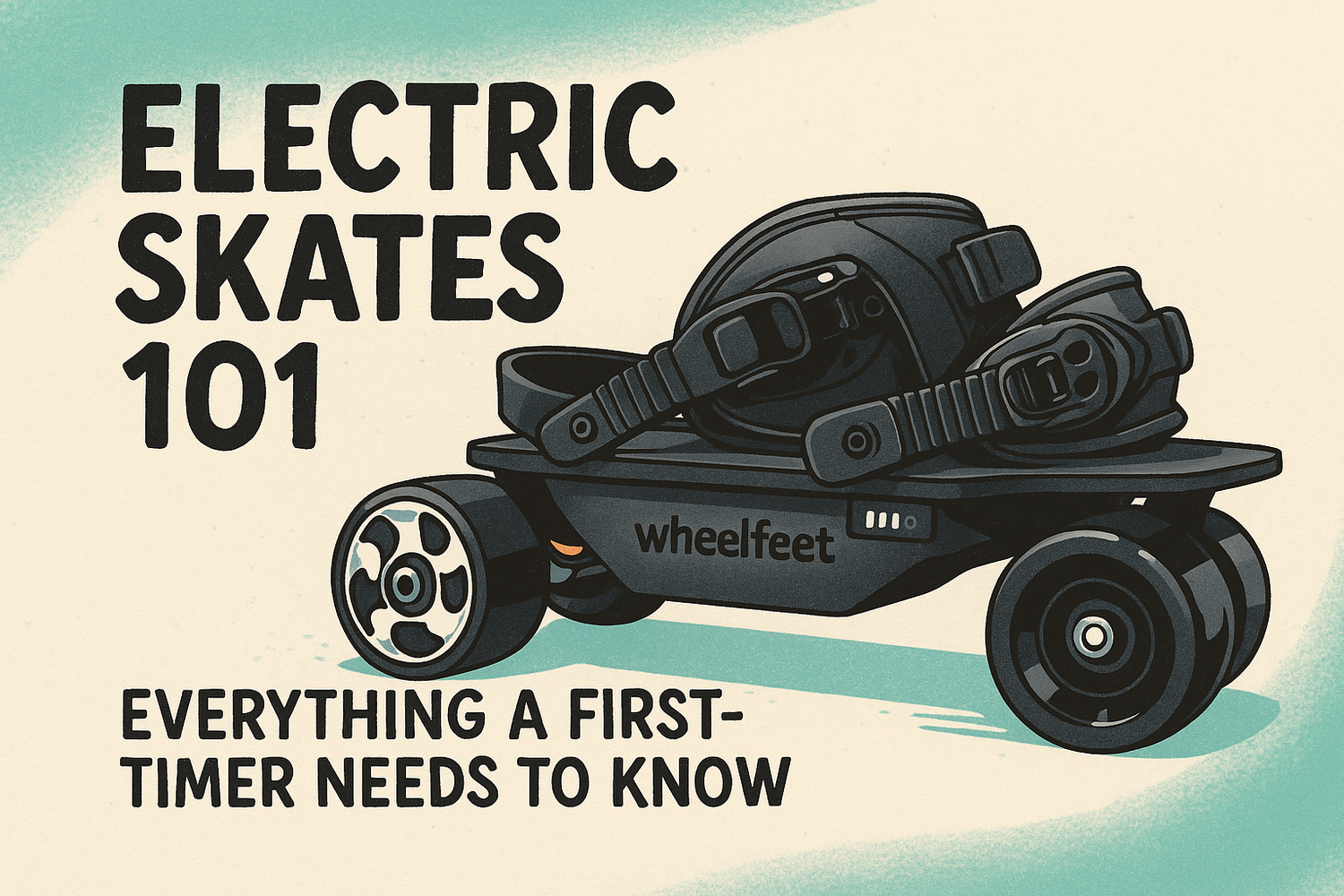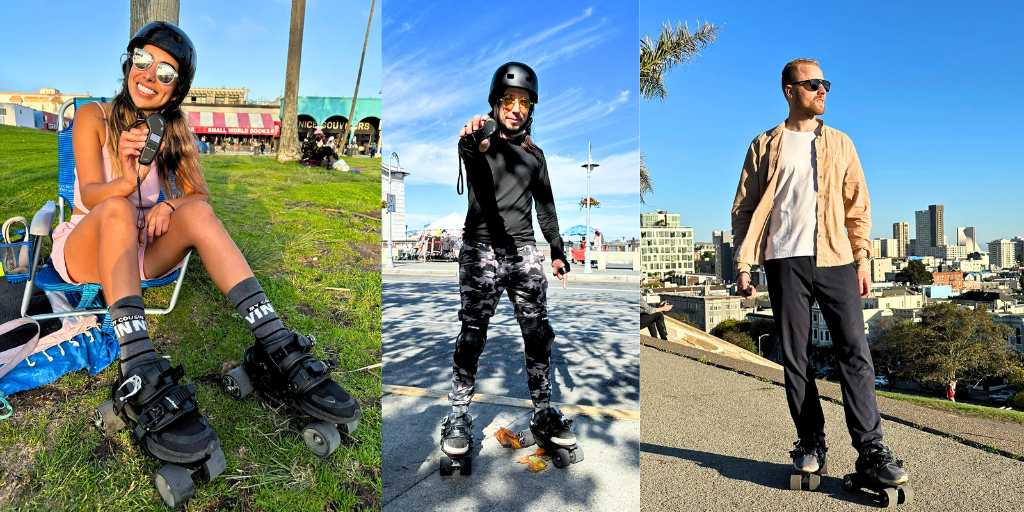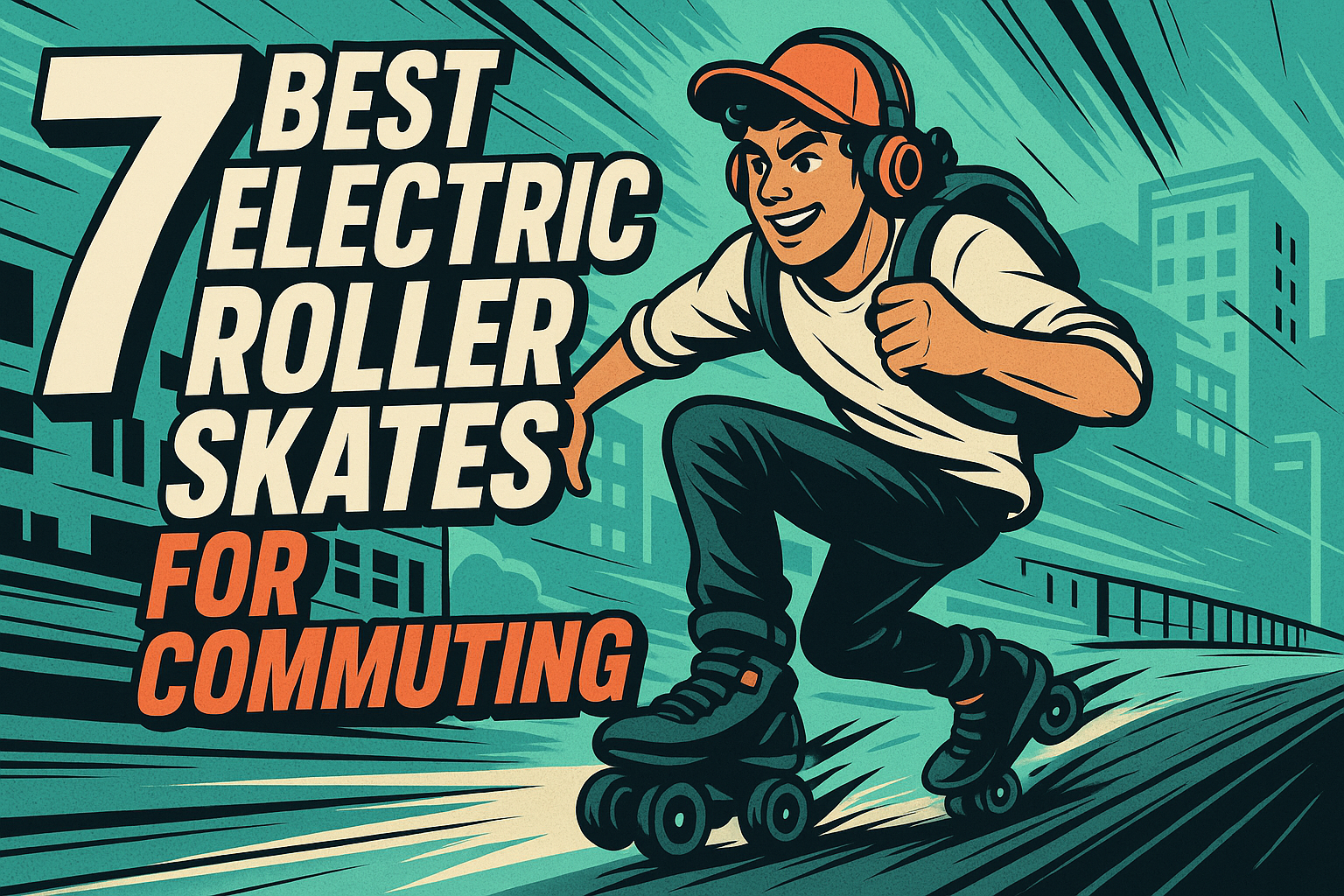Electric skates are redefining short-distance travel in 2025, combining the fun of skating with motorized convenience. Designed for urban lifestyles, these lightweight, portable devices reach speeds up to 15 mph and offer ranges around 9 miles per charge. Perfect for beginners and commuters alike, they prioritize safety with features like regenerative brakes, adjustable speed settings, and wireless remotes. With proper gear - helmets, pads, and wrist guards - you can enjoy a safer ride while reducing your carbon footprint. Starting at $200, models like Wheelfeet ($599) strike a balance between performance and affordability. Ready to glide through your city streets? Let’s dive into the details.
10 Tips every new electric skateboard rider should know
How to Choose the Right Electric Skates
Picking your first pair of electric skates is all about balancing how you plan to use them, your skill level, and what features matter most to you. By understanding these factors, you can make a choice that prioritizes both safety and enjoyment. Let’s break down the key aspects to consider when selecting your skates.
Key Features to Look For
Speed and Control Settings are essential, especially if you’re new to electric skates. Opt for models with adjustable speed settings so you can start slow and build confidence over time. Most skates offer speeds between 10–20 mph, while some advanced options can hit up to 25 mph.
Safety Mechanisms should always come first. Look for features like regenerative brakes, which not only provide smooth and controlled stops but also recharge the battery as you ride.
Range and Battery Life determine how far you can travel on a single charge. If you’re commuting or just cruising around town, a range of about 9 miles should cover most needs. Keep in mind that factors like rider weight, terrain, and riding style can impact battery performance.
Weight Considerations are important for portability. Models around 4.4 lbs per skate strike a good balance between being lightweight and durable.
Proper Fit is key for comfort and control. Many guides suggest going up one size from your usual shoe size, and for those with wider or narrower feet, adjustable laces or insoles can help customize the fit.
Motor Power and Wheel Hardness play a big role in performance. A strong motor helps tackle inclines and rougher terrain, while wheel hardness affects grip and durability. Softer wheels (78A–82A) absorb shocks better on uneven surfaces, whereas harder wheels (95A–100A) are ideal for smooth, indoor skating.
Wheelfeet Electric Roller Skates Overview

Wheelfeet skates are designed with beginners and urban commuters in mind. These skates reach speeds of up to 15 mph and offer a 9-mile range on a single charge. The regenerative braking system enhances safety while extending battery life, making these skates a solid choice for those new to electric skating.
Priced at $599.00, Wheelfeet skates fall into the mid-range category, offering great features for the price. They accommodate U.S. shoe sizes 6–13 (38–47 EU), making them suitable for most adults.
The wireless remote control is a standout feature, allowing users to adjust speed and brake easily without complicated footwork - a big plus for beginners. Reviews often highlight their comfort and ease of use.
"Reason I like them is because they are comfortable, they fit, lock in, quick and easy. You can get out of them quickly too. I like that you able to travel and skate anywhere anytime. Definitely recommend them!" – Brian Burke, Wheelfeet Customer
With a 5.0 out of 5 rating, Wheelfeet skates have earned high praise for their stability and fun factor. Many users enjoy how these skates make commuting more enjoyable while remaining reliable for everyday use.
Matching Skates to Your Needs
When choosing skates, think about how you’ll use them. Commuting and recreational needs vary. If you’re commuting, prioritize battery range and portability. For recreational use, features like higher speeds and fun extras might matter more. Wheelfeet skates strike a balance, making them versatile for both purposes.
Terrain Assessment is another key factor. If you’re skating on smooth sidewalks or bike paths, most electric skates will work fine. For rougher surfaces, look for models with softer wheels. If you’re dealing with steep hills, a more powerful motor is essential.
Skill Level Matching is crucial for safety. Beginners should go for skates with lower top speeds and comprehensive safety features, allowing for gradual improvement as they gain confidence.
Personal Preferences also come into play. Some riders prefer the lateral stability of traditional roller skates, while others like the sleek design of inline configurations. Choose based on what feels right for your style and needs.
Budget Considerations help narrow your options. Entry-level skates typically cost $200–$400, while mid-range options like Wheelfeet are priced between $400–$600. High-end models can exceed $1,500. For most beginners, mid-range models offer the best mix of features and value.
Finally, with North America holding over 42.5% of the market share, you’ll find good local support and easy access to parts and maintenance services. This is an important consideration for long-term use.
Safety Gear and Preparation
Before hopping onto electric skates, gearing up with proper protective equipment is a must. Here's why: skateboarding-related activities lead to about 50,000 emergency room visits and 1,500 hospitalizations annually in the U.S., with most hospitalizations involving head injuries. Interestingly, one-third of these injuries happen to beginners. Studies show helmets can reduce head injuries by 85%, elbow pads by 82%, and knee pads by 32%. These numbers highlight how critical safety gear is for any rider.
Essential Protective Gear
Helmets are the most important piece of safety equipment. Head injuries are the leading cause of severe outcomes in skating accidents, but wearing a well-fitted helmet can lower the risk by up to 85%. For electric skates, choose a helmet that meets safety standards like those set by the U.S. Consumer Product Safety Commission (CPSC) or the Snell Memorial Foundation.
When picking a helmet, consider your riding style. A standard skateboard helmet works for slower, casual rides, but if you're tackling higher speeds, a full-face helmet provides extra protection. Replace your helmet after any major impact or every five years, whichever comes first.
Wrist Guards are also crucial. When riders fall, they often use their hands to break the fall, making wrist fractures one of the most common injuries. Look for gloves with palm sliders or slide protection to protect your hands while maintaining a good grip.
Knee and Elbow Pads shield you from painful scrapes and gravel burns, reducing the severity of injuries when you hit the ground. Opt for pads with sturdy plastic caps and thick foam for maximum protection.
A starter kit, including a dual-certified helmet, slide gloves, knee and elbow pads, and reflective ankle bands, typically costs less than $150. Considering the high cost of medical bills, this is a wise investment.
| Gear Type | Primary Benefit | Injury Prevention Rate |
|---|---|---|
| Helmet | Reduces risk of head injury and fatality | 85% of head injuries |
| Wrist Guards | Prevents wrist fractures and hand injuries | Significant reduction |
| Knee Pads | Protects against cuts, scrapes, and gravel burns | 32% of knee injuries |
| Elbow Pads | Shields from road rash and impact | 82% of elbow injuries |
Proper fit is just as important as the gear itself. Ill-fitting equipment can compromise both safety and comfort.
Getting the Right Skate Fit
The right fit makes all the difference. Poorly fitting gear can reduce control and increase the chances of an accident. Start by measuring your head circumference with a flexible tape around the widest part of your forehead to find your helmet size.
For helmets, compare your measurements to sizing charts. A helmet should fit snugly but not uncomfortably tight, and it shouldn't shift when you move your head. It should sit low on your forehead, not tilted back. Keep in mind that skateboard helmets are designed for multiple impacts, unlike single-impact bicycle helmets.
Pads also require proper measurements. For knee pads, measure about 4 inches above and below your knee. For elbow pads, measure around your arm 4 inches above and below the elbow. For wrist guards, measure around your hand at the knuckles, excluding the thumb.
| Size | Head Circumference | Above Knee | Below Knee | Elbow Pads | Wrist Guards |
|---|---|---|---|---|---|
| Youth/X-Small | 18.5" – 20.0" | 9" – 11" | 6.5" – 8" | 6.0" – 7.0" | 5.5" – 5.7" |
| Small | 21.3" – 22.0" | 12" – 14" | 9" – 11" | 8.0" – 9.0" | 5.7" – 6.5" |
| Medium | 22.0" – 22.8" | 15" – 17" | 11" – 13" | 10.0" – 11.0" | 6.5" – 7.0" |
| Large | 22.8" – 23.6" | 18" – 20" | 14" – 16" | 11.0" – 12.0" | 7.0" – 8.5" |
| X-Large | 23.6" – 24.4" | 21" – 23" | 17" – 19" | 13.0" – 14.0" | N/A |
It's a good idea to go for a slightly smaller size since straps and padding tend to loosen over time. Pads should feel secure without cutting off circulation and should stay in place during movement.
Taking the time to ensure your gear fits properly will not only keep you safer but also make your rides more enjoyable.
Basic Techniques and Safety Tips
With your safety gear securely in place, it’s time to get comfortable with the essentials. These foundational techniques are key to riding electric skates confidently while staying safe.
Learning the Basics
Before turning on your skates, spend some time understanding how they feel. Stand on them without motor assistance to get a sense of your balance. Electric roller skates come as two separate motorized units - one for each foot - which can feel quite different from traditional skates.
When mounting, hold onto something stable for support. Step onto one skate first, then the other. To dismount, reverse the process to step off safely.
Adopt a low, balanced stance: bend your knees, keep your feet shoulder-width apart, and use your arms for balance. Practice in a safe, flat area like an empty parking lot or a smooth park path. Start with a low power setting and shift your weight gradually to activate the motors.
Learning to stop properly is essential. Most electric skates have braking systems that engage when you shift your weight backward. Practice stopping in a controlled environment until it feels instinctive. Avoid relying on jumping off as your primary way to stop - it’s not safe.
To turn, lean in the direction you want to go while keeping your knees bent. Strengthening your legs with exercises like squats and leg presses can help improve your control.
Once you’re comfortable with these basics, it’s important to watch out for common beginner mistakes that could hinder your progress or compromise your safety.
Common Beginner Mistakes
One frequent mistake is accelerating too quickly or making abrupt stops, which can lead to crashes. Stick to a controlled speed until you’re more confident in your skills.
Standing too upright is another common error - it throws off your balance. Keeping your knees slightly bent helps you stay flexible and in control.
Distractions can also lead to accidents. Stay focused on your surroundings and avoid multitasking while riding.
Skipping a pre-ride inspection is risky. Always check your skates to ensure they’re in good working condition before each ride.
Be mindful of the terrain. Riding on wet or uneven surfaces increases your chances of falling. Electric skates perform best on smooth, dry pavement.
Another overlooked skill is learning how to fall safely. Spend time practicing falling techniques in a controlled environment to reduce the risk of injury.
Finally, don’t neglect emergency braking practice. Knowing how to stop quickly and instinctively can make a big difference in avoiding unexpected obstacles.
Once you’ve mastered these basics, you’re ready to apply your skills in urban settings.
Safe Riding in U.S. Cities
Before heading out into urban areas, make sure you’re familiar with local regulations. Electric skate laws vary widely across the United States. For example, California allows electric skates on roads and bike lanes (but not sidewalks) with a typical speed limit of 15 mph. New York City restricts their use to private property, and Texas laws differ from city to city.
Visibility is crucial, especially at night. Wear bright clothing and add reflective elements to your gear, as many accidents happen because drivers or pedestrians don’t see skaters approaching.
Follow traffic laws as if you were riding a bicycle - stop at red lights, yield to pedestrians, and ride in the same direction as traffic when on the road.
Whenever possible, ride with a buddy, particularly if you’re new to electric skates. A partner can help spot potential hazards and provide support if needed.
Avoid riding under the influence of alcohol or other substances, as they impair balance, reaction time, and judgment.
Choose your routes carefully. Stick to bike lanes, park paths, or quieter streets, as busy roads with heavy traffic aren’t ideal for electric skates.
"A great experience starts with staying safe. Prioritizing safety allows you to fully unwind and enjoy the journey. Thus, when using your electric skateboards, commit to good habits, maintain your board properly, and pay attention to your surroundings. Enjoyment comes from knowing you're riding responsibly!" - Meepo Board
sbb-itb-bf837b9
New Technology Features for 2025
Electric skates have come a long way, and 2025 introduces exciting updates that make them even more accessible and safer. These advancements specifically address common concerns for first-time riders, such as balance, control, and overall safety. By refining the core features already in place, these new technologies aim to improve the experience for beginners and seasoned users alike.
Key Features to Watch For
-
Regenerative Braking Systems:
Regenerative braking has transformed how beginners stop safely. This system not only ensures smooth and controlled deceleration but also recharges the battery while braking, offering up to 15% more range. It’s a practical way to ease into safe stops while extending your ride time. -
Wireless Remote Controls:
The latest wireless remotes now come with better responsiveness and built-in battery indicators. This means riders can enjoy a seamless experience without worrying about sudden power loss during their journey. -
Dual-Mode Operation:
Some models now allow users to switch between motorized and manual skating. This dual-mode feature is perfect for beginners who want to practice their balance and movement skills without relying on electric assistance. -
Advanced Battery Technology:
New battery designs charge faster and are built to withstand light rain or damp conditions, making them more reliable for everyday use. Less downtime and more durability mean you can focus on enjoying your rides. -
AI Learning Systems:
Artificial intelligence now plays a role in adapting to your unique movements. These systems make skates more intuitive and responsive, helping riders build confidence as they learn.
Wheelfeet's New Features
Wheelfeet has integrated these cutting-edge innovations to create a more beginner-friendly experience for users in the U.S. Their wireless handheld controller offers four speed settings - Low, Medium, Fast, and PRO - allowing riders to start slow and gradually pick up speed as they gain confidence. Plus, adjustable bindings accommodate shoe sizes from US 6 to 13 (EU 38–47), ensuring a snug and secure fit for a wide range of users.
Wheelfeet’s regenerative braking system ensures smooth stops while extending battery life, addressing two common concerns: safe stopping and range anxiety. With added weather resistance, a sturdy aluminum frame, and durable wheels, these skates are built to handle various urban terrains.
Customer feedback highlights how these features come together to create a seamless and enjoyable experience for new riders. Alex, a first-time user, shared:
"When I heard that they are electric, I had to try them. They are pretty fun! I find them very easy, had very good stability. With the remote control you can control the speed going forward or backward. You can choose how fast you want to go. Thanks to them you have freedom where you can still skate on your own and then you can just use the motor assist."
Another rider, Engel, praised the safety-focused design:
"Wheelfeet are pretty sturdy and safe. The speed control is perfect, you can go fast, you can stop with it easily, I love them, they are so much fun."
These enhancements make 2025 an ideal time for beginners to explore electric skating. With features designed to simplify the learning process and ensure safety, urban rides have never been more enjoyable or approachable.
Conclusion
Electric skating in 2025 has never been more accessible or enjoyable. Your success as a skater hinges on making informed decisions that prioritize safety, comfort, and steady skill development. When selecting your first pair of electric skates, focus on beginner-friendly speed settings, durable materials, a proper fit, and dependable safety features. These essentials set the foundation for a safe and rewarding skating journey.
As we’ve explored, the right gear and a cautious approach to speed can do more than just keep you safe - they elevate your overall experience. Investing in certified helmets, wrist guards, and pads not only reduces the risk of injuries but also boosts your confidence as you progress.
Technology has also made electric skating more approachable for beginners. Features designed to enhance control and safety allow you to build confidence at your own pace. Dana Watson, a daily commuter, shares her experience:
"I purchased a pair of Wheelfeet electric roller skates last month and I've been using them daily for my commute. They are incredibly fun and get me where I need to go quickly without a sweat! Battery life is impressive too. Highly recommend it for anyone looking to add a little excitement to their routine."
Choosing quality skates is a smart long-term investment. Entry-level models are priced between $200 and $400, while mid-range options like Wheelfeet, priced at $599, offer advanced features and greater durability . High-quality skates with sturdy frames and reliable brakes can save you money over time by reducing maintenance and replacement costs.
This guide offers practical tips to help you combine eco-friendly commuting with the thrill of electric skating. Whether you’re navigating city streets or gliding through local parks, the right preparation, reliable equipment, and gradual skill-building will ensure years of safe and enjoyable rides. Have fun out there!
FAQs
What safety gear should I wear when riding electric skates, and why is it important?
When using electric skates, making safety a priority is non-negotiable. Wearing protective gear is a simple yet effective way to reduce the chances of getting hurt. Here’s what you’ll need:
- Helmet: Shields your head from serious injuries in case of falls or collisions.
- Knee and Elbow Pads: Absorb impact and help prevent scrapes, bruises, or worse.
- Wrist Guards: Offer support and protect against wrist sprains or fractures if you fall forward.
This gear is especially crucial for beginners. Not only does it keep you safer, but it also boosts your confidence as you get the hang of riding. By gearing up properly, you can focus on enjoying the ride without unnecessary worries.
How can I choose the best electric skates for my skill level and how I plan to use them?
Choosing the Right Electric Skates
Picking the perfect pair of electric skates comes down to your skill level and how you plan to use them. If you're just starting out, go for skates made with beginners in mind. These models are usually more stable and easier to control, making them ideal for learning the ropes.
For commuters, focus on skates that offer comfort, stability, and a battery that can go the distance. On the other hand, if you're gearing up for off-road adventures, you'll need something tough - look for skates with rugged tires and solid traction to handle uneven terrain. And if tricks or freestyle skating is your thing, lightweight and responsive skates with advanced features will give you the maneuverability you need.
Matching your skates to your skill level is key for both safety and fun. If you're new to electric skates, starting with beginner-friendly options is a smart way to build confidence while mastering the basics.
What are some common mistakes beginners make with electric skates, and how can I avoid them?
Beginners often stumble into a few avoidable mistakes when using electric skates, but a little preparation can make all the difference for a safer and more enjoyable ride.
One of the biggest missteps is skipping protective gear - helmets, knee pads, and wrist guards aren't just accessories; they're your first line of defense against injuries. Another common error? Jumping straight into high speeds. It's tempting to push the limits, but starting slow is key to building confidence and mastering control. Some riders also forget to consider their surroundings, ignoring local traffic laws or choosing risky surfaces like wet or uneven terrain, both of which can lead to accidents.
To steer clear of these issues, always suit up with proper safety gear, stick to smooth and open areas for practice, respect local regulations, and gradually work your way up to higher speeds as your skills improve. With these precautions, you'll be gliding safely and confidently in no time!




Leave a comment
All comments are moderated before being published.
This site is protected by hCaptcha and the hCaptcha Privacy Policy and Terms of Service apply.